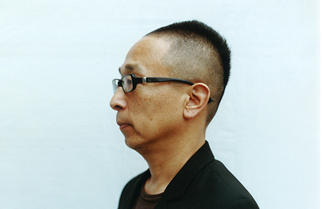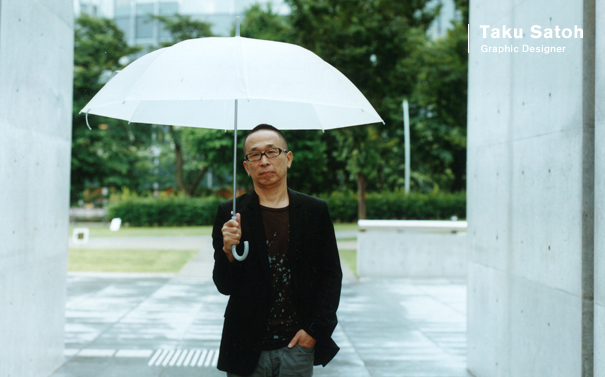
06 Taku Satoh (Graphic Designer)
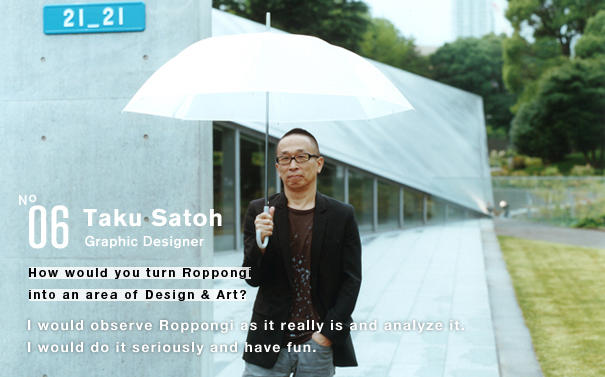
Taku Sato is known as a graphic designer with a sharp eye and a distinctive way of analyzing things. He is one of the directors of the "21_21 DESIGN SIGHT" - a design facilty that was opened at the same time as Tokyo Midtown. The sight of Satoh holding an umbrella recalls to mind the "water" exhibition that he directed in the first year of the facility. Five years have passed since that exhibiton. We asked Satoh about how he feels about this place today, and what kind of things he finds interesting about Roppongi.
Looking lovingly at the front and back of Roppongi
I don't think the proper way of creating a town is to say, "Let's make Roppongi into this kind of place" and then try to impose an image you have come up with while stting at a desk. The left side of the kanji character for "machi" (town) stands for people. So the true way of making a town is through people interacting with each other and building together. Roppongi is not a new place that needs to be built from zero. It already has history, so you need to look at what already exists here. If you do this, you will definitely begin to see what aspects should be valued.
So my proposal is to take a really close look at Roppongi, and make an analysis. For example, it might be interesting to analyze the clothes of the young men standing near the crossroads who look like bad guys. Perhaps if you could clarify why they look that way, you will be able to categorize their clothing into 10 different types, for instance. There's no point just talking about the nice aspects of Roppongi as if those bad guy-looking men aren't there, because they do exist. Of course, if you study them too deeply, you might not feel like walking the streets at night. (laughs) But you know, I'm interested in the things that everyone avoids. So I would first look at Roppongi squarely. And then I would take a look from the opposite side, in a loving way. (laughs)
Observing and analyzing the place through a "Roppongi" exhibition
It might also be a good idea to make a rough list of all the keywords that define Roppongi. The reality of Roppongi is what makes it interesting, so you should come up with keywords that describe the real Roppongi as accurately as possible. After making a thorough observation and objectively analyzing the results, you might be able to hold a "Roppongi" exhibition that could have historical significance.
The things people do are funny and interesting. I enjoy watching people. There are people who don't like towns like Roppongi, who say they don't like the crowds, but I don't feel that way at all. I feel assured when there are people around. It's the people who interest me. Roppongi is a place where you can encounter all kinds of people and all kinds of cultures. That is the attraction of this place.
Why not move the highway above the crossroads underground?
One is free to have thoughts, so I will venture to say it, but I wonder if the highway above the Roppongi crossroads could be transferred underground? The fact that those crossroads are overshadowed by the highway seems to have a large influence on the personality of Roppongi. Biologically speaking, dark and humid places which do not get sunlight are the habitat for creatures that are not very clean... So the question is, "How do we brighten up that place under that highway?" Many steps must have been taken so far, but as long as that highway exists, any attempts to brighten up that place will be in vain. I think this is one of the big challenges that Roppongi faces.
In line with the concept for turning Roppongi into an area of design and art, perhaps you could start a large project to move the highway underground, and have artists and designers involved in the project. If we could get back the wide skies again, the scenery will be dramatically changed, and I feel that a different breed of people will begin to gather.

Tokyo is my beloved hometown
I was born in Tokyo's Suginami ward, and grew up in Shakuji in Nerima ward, so Tokyo is my hometown, and I have never once wanted to leave Tokyo. The new and the old are all mixed together here. It is an interesting place indeed. Tokyo is my favorite city in the whole world.
There are people who say they want to get out of this grimy place as soon as they can, or that they find it difficult to live here, but that kind of talk sounds impolite to me because this is my hometown. I feel that it's the people who don't like Tokyo who are making it a difficult place to live in. They throw garbage in the streets and drive their cars recklessly. I love Tokyo, so when I see these sort of people, I get angry and wish I could become a policeman and say, "Hey, you are driving too carelessly."
Even if you are not from Tokyo, if you have a positive view of where you live, and think it an interesting or wonderful place, you would treat it nicely. I suppose the same things can be said about Roppongi.
Roppongi - a place to encounter different cultures
I first came to Roppongi to go to the discos. (laughs) I was in my 20s, and working at Dentsu at that time. There was a new-wave & punk disco called "Climax". They played extreme music there, and I would go there every week. My hair was cut very short then, and I wore flamboyant glasses. I dressed flashily, wearing things like emerald green pants with bright yellow sweaters and bowling shoes. (laughs) There were models at Climax, so I absorbed a lot of things like hairstyles, clothes, music, and the way people danced.
Climax
A disco popular in early 80's attracted lovers of kinds of music not only new-wave, but also reggae and punk music. It was located inbetween Nishiazabu Crossing and The National Art Center, Tokyo. Currently exists a restaurant-bar called "Mandy".
I also visited AXIS quite a lot. This was a serious place for design. In those days, foreign-made products and interior-related items were not available anywhere in Japan as they are now, and there were things that you had to go to AXIS to see. Both discos and AIXS offered a type of excitement that could not be found in any other areas, and Roppongi was unmistakably the place for encountering different cultures.
A town that now has "21_21 DESIGN SIGHT"
My relationship with Roppongi is still continuing today with my involvement in "21_21 DESIGN SIGHT". This started when Issey Miyake-san said to me, "There's a plan for a facility to be built in Tokyo Midtown on the theme of design. Would you be interested in joining the project?" That was in 2005. The plan got underway, and I visited the construction site and I remember looking into the deep hole that had been dug into the ground, and thinking, "Wow, this is going to become an incredible place."
"21_21 DESIGN SIGHT" is a very low building, shaped as if crouched on the ground, and when it was being built, I couldn't imagine what kind of contrast it would make with the tall buildings in Tokyo Midtown. Now that five years have passed, the trees and bushes have grown, and with the wide lawn, the place looks lovely. And it's not only the surrounding greenery that has grown; I really feel that in the last five years, the "21_21 DESIGN SIGHT" has also grown, bit by bit.

21_21 DESIGN SIGHT
The building was designed by architect Tadao Ando. His architectual design concept was inspired by Issey Miyake's design concept, "a piece of cloth". It is represented in his actual designs inclding a roof looking like a piece of folded giant steel plate and the longest seamless glass nationwide and so forth. Cutting-edge Japanese technology is fully exsercised in the design of this buidling.
Address: 9-7-6 Akasaka, Minato-ku, Tokyo, Japan
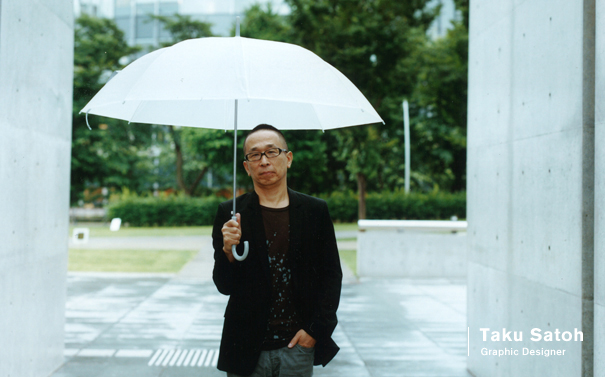
Design serves as a platform
Everything about the facility was for the first time. It was the first design facility of its kind in Japan, and of course the events taking place in it were for the first time. For the second planned exhibiton which I directed, the theme was water; holding an exhibition on water was quite adventurous in itself. Ever since, I've refrained from simply lining up and introducing items at exhibitions, but have instead tried to create places where people can experience "invisible" designs. I've continued to search for all kinds of ways to explore the potential of design.
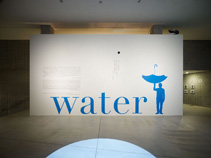
water
The second exhibiton of 21_21 DESIGN SIGHT held from Oct. 2007 to Jan. 2008. This was an experimental exhibition project connecting design and water from a wide-ranging of perspectives not only just exhibiting objects but also publishing, creating website, holding talkshows and workshops. The figure holding an upside-down unbrella is Taku Satoh, director of this exhibition.
Working as a director at the "21_21 DESIGN SIGHT" has convinced me that design is essentially a platform. At art college, there are various departments such as for sculpture, Nihonga (Japanese paintings), oil paintings, crafts and design, and people tend to think of design as being categorized. But design is not restricted to a certain category; it is related to everything in the world - including medical services, and even politics and the economy.
Even doctors need to know about design
At medical college these days, students are required to take lectures on communication. Doctors need to properly inform their patients about their symptons. So it's important to know what kinds of words to use, and how to explain things so that the patients don't become unnecessarily worried. Words are at the base of communication and writing are words made visible. Even doctors need to know about the many kinds of written materials that are handed to the patients. They need to know about the size and color and style of the font and so on. What can be done to make the writing accurate, concise, and easy-to-understand? Having that kind of question in mind is what design is about.
There are heaps of things in the world that need good design. At "21_21 DESIGN SIGHT", we look at each of those things, one by one. It's a place where people become aware of such specific things, and now, after five years, we're getting an increasingly substantial response.
Everything in front of my eyes is interesting!
When you look at things from the perspective of design, there is absolutely nothing that is uninteresting. For example, when I was planning an exhibition on Jomonese, we discovered numerous important keywords to describe the Jomon period - words that contemporary society has forgotten about. And at the "Temahima" exhibiton which was themed on food and lifestyle in the Tohoku region, we learned about Tohoku's long and wonderful tradition of handmade things, and saw how we could make them relevant today.
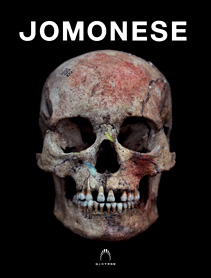
JOMONESE
It is a printing book titled "JOMONESE" published by Bijutsu Shuppan Holdings Co., Ltd. after an exhibition "Jomon-Jin (Jomonese)" held at the National Museum of Nature and Science in Ueno based on a thought "we have something to learn from lifestyles of period of Jomon". All picture including the one on the cover page were taken by photographer, Yoshihiko Ueda. They are pictures of male and female remains from Jomon era. This big-sized book shows anthropological feature of Jomonese and how they lived the era.
In the past, when people asked me, "What's the next thing you want to do?" I would feel afraid of not having a ready reply, and would blurt out that I wanted to design a car or some household appliance. Now though, the project that is sitting right in front of my eyes is always interesting to me. And I want to be serious and riveted on whatever is in front of me.
Nowadays, to be serious is the most radical thing to be. What used to be a "radical" in the past is no longer radical these days because it has become just a pattern. Everyone is trying not to be serious now. So in order to go to the other extreme, you have to be utterly and thoroughly serious, and thus be "dangerous" . I mean dangerous in a good sense. To continue being dangerous in this way gives me the greatest pleasure.
Editor's thoughts
It was raining on the day we interviewed Satoh-san. We asked him to pose with an umbrella, evoking the image of the logo for his "water" exhibition. In his role as one of the directors of 21_21DESIGN SIGHT, Satoh-san is already working to turn Roppongi into an area of design and art. Hearing him talk confidently about his innovative ideas, I felt that his ideas were indeed feasible. (edit_rhino)




